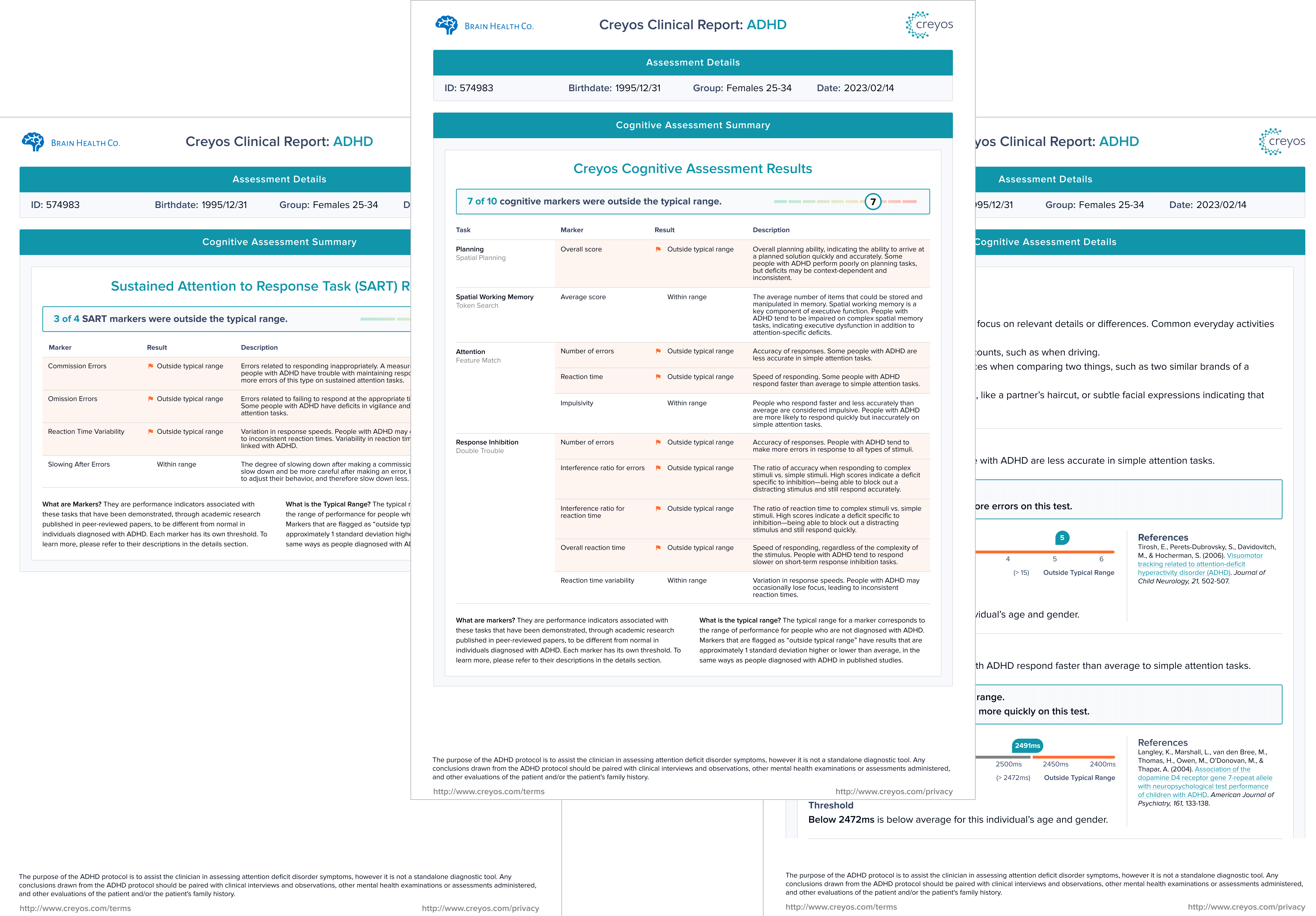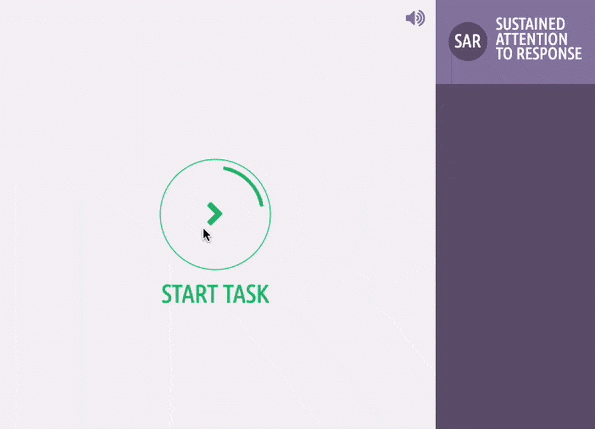
With greater awareness of attention deficit hyperactivity disorder (ADHD) among the public, clinicians face more requests from patients for ADHD testing. Widespread awareness, open conversations, and reduced stigma are all positives. But more people may be self-diagnosing ADHD, based on symptoms they learn about online.
So the pressure comes back to healthcare providers to offer clarity and accuracy around ADHD diagnosis. With a lot of subjective information out there, clinicians have an opportunity to use objective measures to give patients clear answers about their cognition and an appropriate path for treatment or referrals.
To meet the challenges of this rising demand, Creyos created a specific ADHD Clinical Protocol and Report, being made available right in the Creyos Health platform.
This report improves patient experiences and outcomes, while offering clinicians the confidence that comes with a protocol that is:
- Scientifically validated
- Built specifically to measure objective markers shown to be associated with ADHD
- A set of objective measurements that complement subjective questionnaires
- Effective for ongoing tracking of efficacy of medication and other treatment on cognition
- Flexibly administered in clinic or at home
In this article, we’ll address the current state of ADHD diagnosis, share the scientific foundation of our assessment, and provide a step-by-step guide for administering and interpreting the Creyos Health ADHD Protocol and Report.
Please note: The Creyos ADHD Clinical Protocol and Report is not a standalone diagnostic tool. As with other Creyos Health assessments, any conclusions drawn from the Creyos ADHD Clinical Report should be paired with clinical interviews and observations, other mental health examinations or assessments administered, and other evaluations of the patient and/or the patient’s family history.
The Rise of ADHD Diagnosis and Treatment
Current Research on the Prevalence of ADHD
Attention deficit hyperactivity disorder (ADHD) has become one of the most common conditions that healthcare providers deal with every day. As per this article in the National Library of Medicine, it is one of the fastest growing conditions, among youth in particular:
National population surveys reflect an increase in the prevalence [of ADHD] from 6.1% to 10.2% in the 20-year period from 1997 to 2016 and experts continue to debate the causes for this trend. On the one hand, while there are children whose diagnoses are irrefutable and undeniably require treatment, some experts worry about the risk of overdiagnosis and subsequent over-prescription of stimulants and other psychotropics. Like with most psychotropic medications, treatment consideration needs to be carefully weighed with regards to potential adverse outcomes.
Other studies are exploring whether instances of ADHD have only increased since the onset of the COVID-19 pandemic in 2020. The causes they cite include “a lack of structure and anxiety about COVID or jobs during the pandemic”.
Challenging the Status Quo of ADHD Assessment
Patients want to know—what assessments are used to diagnose ADHD? With the readiness of social media information on ADHD, a person who identifies with the symptoms might first turn to a Google search for “ADHD tests online,” seeking to validate their experience.
As you can imagine, many online diagnostic tools don’t have scientific credibility. On the other hand, patients might feel hesitant to bring their concerns to a clinician because of the long and costly processes typically involved in getting an ADHD diagnosis:
- 6 to 8 month referral and booking period wait times
- 1 to 3 hour neuropsychiatric assessment
- Out-of-pocket expenses for the patient
While other computerized assessments for ADHD also exist, they often require:
- More than 20 minutes to complete continuous performance tasks
- ADHD specialists to administer assessments and interpret results
- Hardware that restricts the setting for completing the tests
How is this impacting clinical workflows? Long wait times and high costs mean clinicians and patients often rely solely on brief ADHD questionnaires and/or clinical interviews to reach a diagnosis. Alone, these questionnaires offer subjective data which may not be enough to justify treatment. The process often leaves all parties wanting more concrete information.
Introducing the Creyos Health ADHD Clinical Protocol and Report
What is the Creyos ADHD Clinical Protocol and Report?
This new report is a direct result of feedback received from the Creyos community and is fundamentally different from the reports and protocols you may have used and reviewed to-date. Specifically, this new report involves five Creyos cognitive tasks that examine 14 specific markers of ADHD. It then highlights whether the individual is within or outside the typical range for each, making it easy to identify atypical performance on markers associated with ADHD.
What Does It Include?
Our new, pre-built ADHD protocol is different from any existing ADHD protocols you may have created or used in Creyos Health. It is made up of:
- Four cognitive tests that efficiently measure aspects of attention and executive function
- The Sustained Attention to Response Task (SART), a short continuous performance task
- An optional, age-appropriate questionnaire
What Are The Benefits?
A key benefit of the ADHD Clinical Protocol and Report is that it takes less than 25 minutes to complete, making it easy for patients to be assessed in the appropriate setting for focus, either in clinic or at home.
The protocol also features the SART, a brand new, 6-minute task within the family of continuous performance tasks commonly used with ADHD populations. The entire ADHD assessment is pre-built and tailored to the condition, so clinicians can easily administer the tasks and produce an objective, precise evaluation.
As with all Creyos Health assessments, an easy-to-interpret report is instantly generated upon completion. The ADHD report you’ll receive:
- Is scientifically validated and objective
- Is based on extensive research (hundreds of papers using Creyos tasks have been published)
- Conveys performance with respect to the typical range on specific ADHD markers, in addition to specific percentile ranks
The Science Behind The ADHD Clinical Protocol and Report
How We Built The ADHD Clinical Report
In speaking to healthcare providers, we consistently heard the need for an objective clinical report focused on ADHD. Our solution became clear: Use the latest neuroscience, drawn from over 350 peer-reviewed studies involving Creyos tasks, to develop a fast and efficient ADHD-focused protocol that results in a comprehensive, yet easy-to-interpret, report.
This ADHD protocol also draws from existing assessments including:
- The Adult ADHD Self-Report Scale, or ASRS
- The Vanderbilt ADHD Diagnostic Rating Scale, or VADRS
- The Strengths and Weaknesses of Attention-Deficit/Hyperactivity Symptoms and Normal Behavior Scale, or SWAN
What are the 14 Markers of ADHD?
The Creyos ADHD protocol is focused on 14 markers—specific cognitive performance metrics within Creyos tasks that are associated with an ADHD diagnosis.
To find markers validated through scientifically-supported associations with ADHD, Creyos examined over 100 peer-reviewed papers. We found:
- Ten markers derived from four existing Creyos cognitive tasks (Spatial Planning, Token Search, Feature Match, and Double Trouble).
- Four more markers derived from the Sustained Attention to Response Task (SART), a task available exclusively as part of the Creyos ADHD protocol.
What is SART?
The SART is a common task used with the ADHD population, and is part of the continuous performance test family—that is, tasks that measure attention and response inhibition over longer periods of time.
As outlined in depth in the Creyos ADHD Clinical Report Science Guide, the SART has proven to be a valid and reliable measure of sustained attention. It specifically measures the ability to sustain mindful, conscious information processing, even in repetitive, boring or distracting situations.
